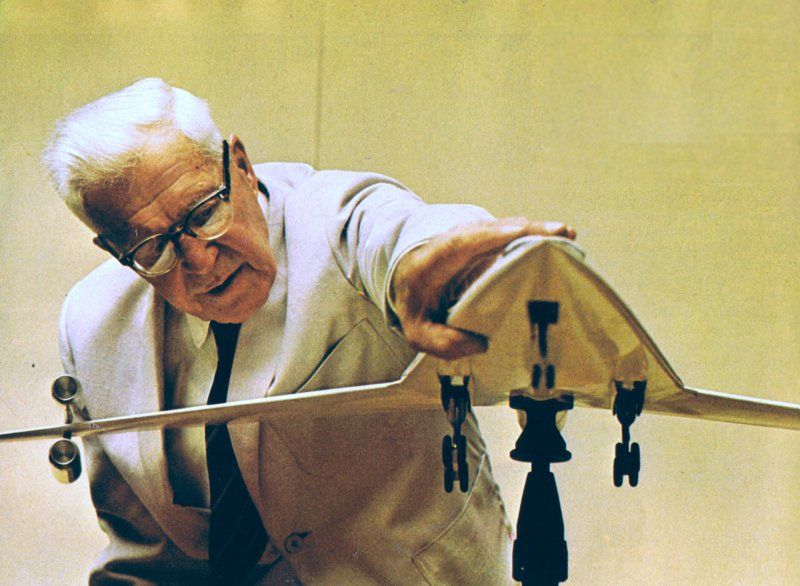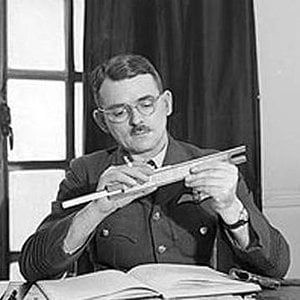Navigation
Install the app
How to install the app on iOS
Follow along with the video below to see how to install our site as a web app on your home screen.
Note: This feature may not be available in some browsers.
More options
You are using an out of date browser. It may not display this or other websites correctly.
You should upgrade or use an alternative browser.
You should upgrade or use an alternative browser.
Aircraft designHis many achievements include the first use of geodetic design in engineering and in the gasbag wiring of Vickers' R100 in 1930, which, at the time, was the largest airship ever designed. He also pioneered, along with John Edwin Temple, the use of light alloy and production engineering in the structural design of the R100. Neville Shute Norway was the chief calculator for the project, responsible for calculating the stresses on the frame. Despite a better-than-expected performance and a successful return flight to Canada in 1930, the R100 was broken up following the tragedy that befell its "sister" ship, the R101 (which was designed and built by a team from the Government's Air Ministry); the later crash of the Hindenburg led to the abandonment of airships as a mode of mass transport.
By the time of the R101 crash, Wallis had moved to Vickers' aircraft division. The pre-war aircraft designs of Rex Pierson, the Vickers Wellesley and the Vickers Wellington, both employed Wallis's geodetic design in the fuselage and wing structures. The latter was one of the most robust airframes ever developed, and pictures of its skeleton largely shot away, but still sound enough to bring its crew home safely, are still impressive. The geodetic construction offered a light and strong airframe (compared to conventional designs) with clearly defined space within for fuel tanks, payload etc. However the technique was not easily transferred to other aircraft manufacturers nor was Vickers able to build other designs in factories tooled for geodetic work.
[edit] Bomb designAfter the outbreak of the Second World War in Europe in 1939, Wallis saw a need for strategic bombing to destroy the enemy's ability to wage war and he wrote a paper entitled "A Note on a Method of Attacking the Axis Powers". Referring to the enemy's power supplies he wrote (as Axiom 3): "If their destruction or paralysis can be accomplished they offer a means of rendering the enemy utterly incapable of continuing to prosecute the war". As a means to do this he proposed huge bombs that could concentrate their force and destroy targets which were otherwise unlikely to be affected. Wallis's first super-large bomb design came out at some ten tonnes, far larger than any current plane could carry. This led him to suggest a plane that could carry it, the "Victory Bomber", rather than drop the idea.
Möhne dam, breached by bouncing bombsEarly in 1942, Wallis began experimenting with skipping marbles over water tanks in his garden, leading to his April 1942 paper "Spherical Bomb — Surface Torpedo". The idea was that a bomb could skip over the surface of water (avoiding torpedo nets) and sink directly next to a battleship or dam wall as a depth charge, with the surrounding water concentrating the force of the explosion on the target. A crucial innovation was the addition of backspin, which caused the bomb to trail behind the dropping aircraft (decreasing the chance of the aircraft being downed by the force of the explosion below), increased the range of the bomb, and also prevented it from moving away from the target wall as it sank. After some initial scepticism, the Air Force accepted Wallis's bouncing bomb for attacks on the Möhne, Eder, and Sorpe dams in the Ruhr area. The raid on these dams in May 1943 (Operation Chastise) was immortalised in Paul Brickhill's 1951 book The Dam Busters and the 1955 film of the same name. The Mohne and Eder dams were successfully breached causing damage to German factories and disrupting hydro-electric power.
Valentin U-boat pen, with its roof of 4.5 metres of reinforced concrete penetrated by a Grand Slam bombAfter the success of the bouncing bomb, Wallis was able to return to his huge bombs, producing first the Tallboy (6 tonnes) and then Grand Slam (10 tonnes) deep-penetration earthquake bombs. These were not the same as the 5-tonne "blockbuster" bomb, which was a conventional blast bomb. Although there was still no aircraft capable of lifting these bombs to their optimal release altitude, these two bombs could still be dropped from a lower altitude, entering the earth at supersonic speed and penetrating to a depth of 20 metres before exploding. They were used on strategic German targets such as V2 rocket launch sites, submarine pens, and other reinforced structures, large civil constructions such as viaducts and bridges, as well as the German battleship Tirpitz. They were the forerunners of modern bunker-busting
By the time of the R101 crash, Wallis had moved to Vickers' aircraft division. The pre-war aircraft designs of Rex Pierson, the Vickers Wellesley and the Vickers Wellington, both employed Wallis's geodetic design in the fuselage and wing structures. The latter was one of the most robust airframes ever developed, and pictures of its skeleton largely shot away, but still sound enough to bring its crew home safely, are still impressive. The geodetic construction offered a light and strong airframe (compared to conventional designs) with clearly defined space within for fuel tanks, payload etc. However the technique was not easily transferred to other aircraft manufacturers nor was Vickers able to build other designs in factories tooled for geodetic work.
[edit] Bomb designAfter the outbreak of the Second World War in Europe in 1939, Wallis saw a need for strategic bombing to destroy the enemy's ability to wage war and he wrote a paper entitled "A Note on a Method of Attacking the Axis Powers". Referring to the enemy's power supplies he wrote (as Axiom 3): "If their destruction or paralysis can be accomplished they offer a means of rendering the enemy utterly incapable of continuing to prosecute the war". As a means to do this he proposed huge bombs that could concentrate their force and destroy targets which were otherwise unlikely to be affected. Wallis's first super-large bomb design came out at some ten tonnes, far larger than any current plane could carry. This led him to suggest a plane that could carry it, the "Victory Bomber", rather than drop the idea.
Möhne dam, breached by bouncing bombsEarly in 1942, Wallis began experimenting with skipping marbles over water tanks in his garden, leading to his April 1942 paper "Spherical Bomb — Surface Torpedo". The idea was that a bomb could skip over the surface of water (avoiding torpedo nets) and sink directly next to a battleship or dam wall as a depth charge, with the surrounding water concentrating the force of the explosion on the target. A crucial innovation was the addition of backspin, which caused the bomb to trail behind the dropping aircraft (decreasing the chance of the aircraft being downed by the force of the explosion below), increased the range of the bomb, and also prevented it from moving away from the target wall as it sank. After some initial scepticism, the Air Force accepted Wallis's bouncing bomb for attacks on the Möhne, Eder, and Sorpe dams in the Ruhr area. The raid on these dams in May 1943 (Operation Chastise) was immortalised in Paul Brickhill's 1951 book The Dam Busters and the 1955 film of the same name. The Mohne and Eder dams were successfully breached causing damage to German factories and disrupting hydro-electric power.
Valentin U-boat pen, with its roof of 4.5 metres of reinforced concrete penetrated by a Grand Slam bombAfter the success of the bouncing bomb, Wallis was able to return to his huge bombs, producing first the Tallboy (6 tonnes) and then Grand Slam (10 tonnes) deep-penetration earthquake bombs. These were not the same as the 5-tonne "blockbuster" bomb, which was a conventional blast bomb. Although there was still no aircraft capable of lifting these bombs to their optimal release altitude, these two bombs could still be dropped from a lower altitude, entering the earth at supersonic speed and penetrating to a depth of 20 metres before exploding. They were used on strategic German targets such as V2 rocket launch sites, submarine pens, and other reinforced structures, large civil constructions such as viaducts and bridges, as well as the German battleship Tirpitz. They were the forerunners of modern bunker-busting








